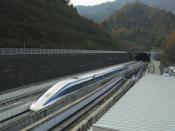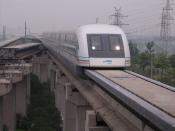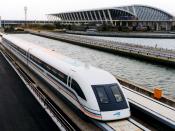Introduction
The future of transportation lies with the Magnetically Levitated, or "MagLev," train. It combines all the benefits of an airplane and the benefits of trains to produce a "Flying Train" (2)
"MagLev technology was pioneered on Long Island New York in the 1960's by two Brookhaven National Laboratory scientists, James Powell and Gordon Danby... who used super conducting magnets for MagLev trains (9)." It is a project that has since been dropped by the US due to lack of government funding. However, it is a technology that is almost at the point of commercial use in Germany and Japan (the 2 major testing facilities) (4).
There are 2 main types of levitation and propulsion which I will explain in this essay, (EMS) Electromagnetic Suspension and ( EDS) Electrodynamic Suspension. EMS is run extremely close to the track (about 10mm), this makes it slightly unstable. EDS however is run much higher above the track (about 100 to 200 mm) making it most likely to be the system used on the first commercially active MagLev trains.
Superconductor
The main problem with the MagLev concept is that it requires extremely strong magnets to levitate the train. For this reason superconductors were used, superconductors are materials which, when heated or cooled to a large amount, become extremely magnetic. The next problem was creating cost effective units, the Japanese accomplished this:
The unit that was used is called the SMS. The SMS uses liquid nitrogen to keep the superconductor being used at the right temperature. Because the nitrogen is continuously being heated due to the fact that it absorbs so much heat, it is cooled using refrigerated helium. (6)
Levitating and Running the Train
There are 2 systems used to levitate and direct the MagLev trains. EMS (electromagnetic suspention and EDS (electrodynamic suspention). EMS...


